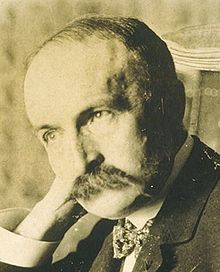Philippe Bunau-Varilla
Philippe Jean Bunau-Varilla (born April 26, 1859 in Paris ; † May 18, 1940 there ; also: Philippe Bunau-Varilla ) was a French engineer , diplomat and soldier . As a lobbyist , he influenced the United States ' decision to build a waterway through Panama , the Panama Canal , and supported Panama's successful breakaway from Colombia in the Panama conflict .
Life
Born out of wedlock in Paris in 1859, Philippe Bunau-Varilla graduated from the École Polytechnique in 1880 and completed the École nationale des ponts et chaussées three years later . He was employed by the Compagnie Universelle du Canal Interocéanique , the (first) French Panama Canal Company, by Ferdinand de Lesseps , and a year later, in 1884, he was posted to Panama, where he quickly rose to Chief Engineer and headed one of the three departments of the Panama Canal Company . At the age of 26, Bunau-Varilla temporarily took over the management of Panama.
When the Lesseps company went bankrupt on fraud charges in 1888, in order to revive French interest, Bunau-Varilla zealously defended the canal idea and wrote two books on the canal. He tried unsuccessfully to get Russian support. In addition, he tried his hand at various projects, including the purchase of the Paris newspaper Le Matin , which he shared with his brother Maurice .
Bunau-Varilla returned to Panama in 1894 when he became a major investor in Compagnie Nouvelle du Canal de Panama , the second French Panama Canal company to take over the concession and other assets of the failed Compagnie Universelle… . The new company gave up hopes of completing the canal and tried to sell the plans to the United States.
The American government initially did not respond. In 1902, however, the US Senate considered whether to choose a Panamanian or Nicaraguan route for a channel between the two oceans. Through the determined efforts of Nelson W. Cromwell, New York attorney for Compagnie Nouvelle… , and later Bunau-Varilla, the United States finally chose the Panamanian route. On various trips to the United States, Bunau-Varilla met celebrities, gave lectures and published a brochure entitled Panama or Nicaragua . To illustrate his design that volcanoes would threaten the Nicaraguan route, he bought Nicaraguan stamps showing the Momotombo volcano spewing ash and smoke and distributed them to every US Senator.
Influenced by such efforts, the US Congress passed the Spooner Act in 1902 , which provided for the construction of canals in Panama if sensible agreements could be reached with Colombia, which Panama was a part of at the time. When the treaty with Colombia was not ratified, Bunau-Varilla eventually supported a Panamanian revolution. In New York he planned with revolutionaries and drafted a proclamation of independence, a draft constitution, a plan for military operations and a flag of the future Panama.
After the successful breakup of Panama, the United States quickly recognized independent Panama. In return, and despite being a French citizen, the Panamanian Provisional Government appointed him Plenipotentiary Minister in the United States. On November 18, 1903 just hours before a Panamanian delegation in Washington, DC arrived, he signed the Hay-Bunau-Varilla Treaty with US Secretary of State John Hay , who gave the right to the United States, both in Panama a channel to build, as well as to take over significant sovereign rights within the Panamanian state left and right of the canal. Ultimately, this contract brought millions for the shareholders of the Compagnie Nouvelle… .
When the Panamanians expressed reservations when ratifying the treaty and protested against provisions that gave the United States rights that directly affected Panama's sovereignty, Bunau-Varilla threatened them with the return of the Colombian armed forces, which in turn shied away from the Panamanian government and the treaty finally agreed.
Returning to France, he devoted himself to railway projects in the Congo and, after the First World War, those for the Paris Metro . As an officer in the French Army during World War I , Bunau-Varilla lost a leg on the Verdun battlefield while overseeing engineering work.
He defended his work in Panama and in the USA in further writings and even stated that this had contributed to Germany's defeat in the war in Panama ( La Grande aventure du Panama, son rôle essentiel dans la défaite de l'Allemagne , 1920). However, it was denigrated in Panamanian publications.
In the late 1920s he devoted himself to methods of improving water hygiene (French: Verdunisation ).
Bunau-Varilla died in Paris on May 18, 1940.
Fonts (selection)
- Panama, le passé, le présent, l'avenir. Panama, le trafic , 1892
- Le Détroit de Panama, documents relatifs à la solution parfaite du Schwierème de Panama détroit libre, large et profond , 1907
- Panama, la création, la destruction, la résurrection , 1913
- La Grande aventure du Panama, son rôle essentiel dans la défaite de l'Allemagne , 1920 ( The Great Adventure of Panama , 1920, in English on net.lib.byu.edu )
- La Verdunisation des eaux , 1929
- De Panama à Verdun: mes combats pour la France , 1937 (autobiography)
Awards
- Chevalier de la Légion d'Honneur (Ch.LH, 1887)
- Officier de la Légion d'Honneur (O. LH, 1904)
- Commandeur de la Légion d'Honneur (C. LH, 1917)
- Grand Officier de la Légion d'Honneur (GO LH, 1930)
- Grand croix de la Legion d'Honneur (GC LH, 1938)
- Croix de guerre with a star and two palm branches
Web links
- Philippe Jean Bunau-Varilla on britannica.com (English)
- Philippe Bunau-Varilla papers, 1877–1955 in the Library of Congress (English)
| personal data | |
|---|---|
| SURNAME | Bunau-Varilla, Philippe |
| ALTERNATIVE NAMES | Bunau-Varilla, Philippe Jean |
| BRIEF DESCRIPTION | French engineer, diplomat and soldier |
| DATE OF BIRTH | April 26, 1859 |
| PLACE OF BIRTH | Paris |
| DATE OF DEATH | May 18, 1940 |
| Place of death | Paris |
